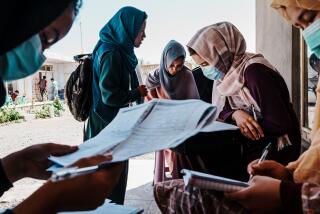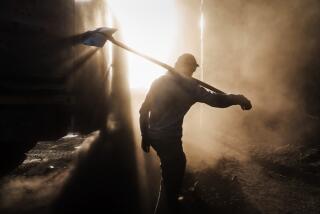Afghanistan’s Toughest Battle Lies Ahead
KABUL, Afghanistan — More than 14 months ago, the U.S. invasion of Afghanistan produced swift and stunning results.
Small teams of Special Forces soldiers and CIA paramilitary officers targeted the enemy for U.S. warplanes while giving millions of dollars in cash and weapons to proxy forces headed by commanders of the Northern Alliance resistance. In a matter of weeks, the Taliban and Al Qaeda were routed and a pro-American government was installed. It was an improvised strategy that hitched U.S. combat technology to Afghan boots on the ground.
Today, the postwar phase of Operation Enduring Freedom is still being improvised, but with less dramatic results and with long-term success far from certain.
As American policymakers lay plans for a possible invasion of Iraq, the Afghan experience is a reminder that the toughest war is often waged long after the fiercest combat ends. Even with the enemy defeated on the battlefield, the fight to stabilize and rebuild a fractured nation can be as draining as any battle fought with infantry and warplanes.
U.S. commanders in Afghanistan are being asked to direct an ambitious effort at nation-building -- the ambiguous and taxing Clinton-era policy ridiculed by candidate George W. Bush. The United States is doubling the number of civil affairs officers assigned to help build schools and clinics, dig wells and provide humanitarian aid in a country where most people are illiterate and live in mud huts.
American combat units, meanwhile, are harassed almost daily by haphazard rocket fire and hit-and-run attacks. Taliban and Al Qaeda fighters enjoy freedom of movement in the lawless tribal highlands of Pakistan, aided by sympathizers in Afghanistan’s rugged eastern border regions. Though several top Al Qaeda leaders have been killed or captured, Osama bin Laden and Taliban leader Mullah Mohammed Omar are still at large.
Like U.S. troops in Vietnam, American soldiers here find it difficult to distinguish ordinary villagers from enemy operatives. Lt. Col. Martin Schweitzer, a battalion commander in eastern Afghanistan, says the enemy hides among civilians and spies on American troop movements and methods from villages across the border in Pakistan.
The operatives use cell phones, walkie-talkies, whistles and even mirrors to warn confederates of U.S. combat patrols, he said.
“They may not have the same type education that we have, but they are incredibly smart,” Schweitzer said. “They are not chumps.”
Throughout the country, security is tenuous. Two Afghan government ministers have been assassinated; their killers remain free. President Hamid Karzai, who has survived an assassination attempt, is guarded by an American security detail. His government has yet to extend its authority beyond Kabul, the capital.
The U.S. military commitment is open-ended. Lt. Gen. Dan K. McNeill, commander of coalition forces here, said it will probably be 18 months to two years before U.S. troop levels, now at about 8,000, can begin to be reduced. He said he expects American forces to remain in Afghanistan, at gradually diminishing levels, for years to come.
A Year of Upheaval
From reporting across Afghanistan over the past year, a portrait emerges of an American effort that has produced profound changes in the lives of ordinary Afghans but also has left a residue of bitterness and mistrust.
The oppressive Taliban regime has been overthrown. Al Qaeda terrorist camps have been dismantled. Twenty-three years of war have come to an end, and one of the world’s poorest countries is inching toward modernity.
But a military campaign that began with a flourish has evolved into a sometimes intrusive police action in a nation with a tradition of fierce resistance to outsiders and a virtually endless supply of weaponry. U.S. forces are seizing and destroying arms caches -- 1.5 million pounds so far -- but warlords’ militias continue to rule by the gun in the absence of government authority.
In part because of airstrikes in the fall of 2001 that killed, by various estimates, several hundred to a few thousand civilians, there is lingering resentment of Americans -- especially in ethnically Pushtun areas in the east and south. While Afghans express gratitude to the United States for ridding the country of the Taliban and Al Qaeda, some say they fear U.S. troops will become a long-term occupying army like the Soviet forces that invaded more than 20 years ago and remained for a decade.
Those misgivings have been compounded by American military support for warlords, most of them Tajiks from the Northern Alliance who helped defeat the Pushtun-dominated Taliban.
The Karzai government is dominated by Tajiks from the Panjshir Valley, stirring further skepticism among Pushtuns about its commitment to the stated U.S. goal of a democratic, multiethnic government.
One measure of popular sentiment is the photos hanging in Afghanistan’s many bazaars. Outside the capital, there are far more photos of local warlords than of Karzai. Even inside Kabul, shops and public spaces are dominated by photos not of the president but of Ahmed Shah Masoud, the Tajik who commanded the Northern Alliance until his assassination by Al Qaeda two days before the Sept. 11 terrorist attacks.
McNeill calls the warlords “regional leaders.” In a recent interview, he said the U.S. military will continue to work closely with them because they provide stability and security. The U.S. goal, he said, is to dismantle the militias once the U.S.-trained national army is deployed and the central government projects authority nationwide.
But for now, the warlords enjoy robust American support. U.S. Special Forces teams conduct operations accompanied by warlords’ militiamen and live in compounds guarded by them. Because many warlords also serve as provincial governors, U.S. military civil affairs teams must work with them to set up reconstruction and humanitarian projects -- thus burnishing their images among the local population.
McNeill said the warlords back the central government and have promised to disband their private armies or integrate them into the evolving national army -- though they have collected an estimated $300 million in taxes and duties that should have gone to the Karzai government they claim to support. The government is so strapped for cash that workers are paid only sporadically.
“They each have interests that are particular to their regions, but they are also interested in seeing this country move forward,” McNeill said of the warlords. “They realize that a centrally controlled army will likely bring more security and stability than anything they’ve seen in the last 23 years.... They’re simply waiting for the central government to show how this will work.”
Four battalions of the nascent national army, with 300 to 400 men each, have been trained by U.S. Special Forces troops since last summer, and two more are in training. Some units have been posted outside the capital for the first time.
In interviews, army trainees reject tribal and ethnic ties and express loyalty to the national government.
“This is our homeland, and I want to defend it,” said Farhid Sharzai, 26, a Pushtun recruit. Abdul Hanan Mufakir, 32, a Tajik, said: “The country is like a mother who must be protected by all her children.”
In Lebanon 20 years ago, recruits in a U.S.-trained national army also repudiated narrow ethnic interests. But that army, dominated by Christian officers from a Christian government supported by the United States, collapsed along ethnic and religious lines in a civil war in which American military personnel were killed by Muslim terrorists.
A Population in Need
As the Afghan army slowly develops, the civilian population remains mired in poverty. At least 1.3 million Afghans will need food aid to survive the winter, according to the United Nations’ World Food Program. Afghanistan, a country of about 27 million, has been overwhelmed by 1.8 million returning refugees, many of whose homes were destroyed or overrun by squatters.
Of the $1.8 billion in aid promised by donor nations this year, $1.5 billion has arrived -- but little has reached rural areas where needs are greatest. A total of $4.5 billion has been pledged over the next five years.
Economic constraints and the lack of central authority have been keenly felt by Zaira Mahdat, headmistress of a small girls school in the provincial capital of Chaghcharan in central Afghanistan.
She said she has not been paid for six months. Local officials steal the meager supplies sent by the Education Ministry or foreign aid groups, Mahdat said as she stood in a classroom devoid of desks, chairs or books. Islamic fundamentalists are trying to shut down the school, saying girls should not be educated.
Grappling With Graft
Corruption is endemic, complicating the jobs of the 350 to 400 American civil affairs soldiers in Afghanistan.
In Herat, a civil affairs officer said that two Western aid organizations have left the city because of thefts of relief supplies and kickback demands by functionaries appointed by Ismail Khan, the regional warlord. A warehouse guarded by Khan’s gunmen was looted of wheat one night, the officer said, and medical supplies donated to a hospital turned up for sale in a pharmacy. It is common to see bags of donated wheat sold in bazaars.
Civil affairs projects are limited to $300,000 each. The Pentagon has provided a civil affairs budget of about $10 million, versus $12.6 billion for Afghan combat operations in the fiscal year that ended in September. The U.S. has contributed $455 million in Afghan aid this year.
A senior U.S. military official said the American effort is not “nation-building.” He described it as “helping provide the Afghan people assistance for their own growth.”
Col. Roger King, the chief U.S. military spokesman in Afghanistan, described the current mission as “to kill or capture Al Qaeda and those who support them, train the [national army] and deny the use of Afghanistan as a sanctuary by the terrorists. In support of this mission, we work to provide an environment where Afghanistan can rebuild.”
Against this backdrop, U.S. combat forces -- assisted by 4,700 troops from the International Security Assistance Force of peacekeepers -- are trying to hold the country together until the central government can step in.
Most of the American military focus is in the east, where Al Qaeda and Taliban holdouts slip back and forth across the Pakistani border, moving weapons, money and bomb-making materials.
U.S. infantry units mount combat sweeps through the same border areas again and again. Villagers say Al Qaeda and Taliban fighters, assisted by local sympathizers, return as soon as the American forces leave -- though the senior military official said that “each time we go back, the conditions improve.”
Under military rules of engagement, U.S. units can enter Pakistan only if fired on by enemy forces that are inside Pakistan or are fleeing there. But because Pakistani President Pervez Musharraf is threatened by Islamic fundamentalists, the United States has limited its forces in Pakistan to small teams of FBI and CIA agents and Special Forces troops.
The situation requires substantial U.S. military operations on Afghanistan’s eastern flank because, as Col. James Huggins, a U.S. commander, put it: “I don’t have enough soldiers to set up a picket line along the border.” (The U.S. plans to finance 177 border stations, to be manned by Afghan border police who are now being trained.)
The enemy’s refusal to fight American forces face to face has left troops frustrated. Capt. Clay Novak, who has led an airborne company on sweeps along the Pakistani border, said he once assumed that Taliban and Al Qaeda holdouts would challenge the Americans.
“They preach a good game about dying for their cause, but the fact is they’ve run away every time,” Novak said after a mission in which his men found weapons but no enemy fighters.
“They’re not going to go up against us,” said Spc. John Ferrante, dressed in body armor and hauling weapons during a combat mission a mile from the Pakistani border. “So as long as we’re here, these areas will be cleared.”
With land mines, snipers, car bombs and tons of unexploded ordnance, Afghanistan remains a dangerous place. Earlier this month, two Special Forces soldiers were wounded when a grenade was tossed into their parked car in downtown Kabul. The same week, an American soldier on patrol was shot and killed by a sniper in eastern Afghanistan.
Since Operation Enduring Freedom began, the U.S. has suffered 26 combat deaths and 137 wounded. An additional 28 soldiers have died and 114 have been injured in aircraft crashes and other accidents.
During a visit to Afghanistan this month, Gen. Tommy Franks, head of the U.S. Central Command, said threats remain despite the decisive U.S. military victory more than a year ago.
“While things seem to be OK for Afghanistan ... we still see a lot of problems,” Franks said. “The truth of it is that while a lot has been done, this is Afghanistan. We’re going to have to stay with it for as long as it takes.”
*
(BEGIN TEXT OF INFOBOX)
Key events in the U.S. war in Afghanistan
2001
Oct. 7: U.S. launches airstrikes in Afghanistan to kill or capture Osama bin Laden and destroy terrorist training facilities in the country.
Nov. 13: Kabul, the Afghan capital, falls to the Northern Alliance, the U.S.-backed resistance movement.
Dec. 5: At a summit in Germany, Afghan delegates agree on a transitional government and choose Hamid Karzai as interim prime minister.
Dec. 7: The Taliban regime collapses; its leaders flee Kandahar. Taliban leader Mullah Mohammed Omar escapes.
Dec. 16: U.S.-backed Afghan fighters take Tora Bora cave complex after weeks of U.S. bombing. No trace is found of Bin Laden, who is believed to be hiding in the fortress.
Dec. 17: Envoy James Dobbins reopens the U.S. Embassy in Kabul, shuttered since the 1979 Soviet invasion.
Dec. 28: President Bush describes a successful U.S. war effort: “Taliban gone, the country secure, the country stable . . . Al Qaeda cells rounded up, Taliban fighters brought to justice.” He adds: “You don’t need to worry about whether or not we’re going to get [Bin Laden], because we are.”
2002
March: U.S. troops battle Al Qaeda and other enemy fighters in Operation Anaconda, called the largest battle of the Afghan war. Eight Americans are killed in fighting in eastern Afghanistan.
Jan. 4: Sgt. 1st Class Nathan Ross Chapman, shot by a 14-year-old Afghan boy, is the first U.S. soldier killed by enemy fire in Afghanistan.
June 13: An Afghan loya jirga, or grand council, selects Karzai as the country’s leader, the first peacefully empowered president of Afghanistan.
July 6: Afghan Vice President Haji Abdul Qadir is assassinated. U.S. Army special forces begin protecting Karzai.
Sept. 5: Karzai survives an assassination attempt. The gunman is killed by Karzai’s American bodyguards.
Nov. 12: An audio statement by Bin Laden surfaces, indicating that the Al Qaeda leader is alive.
Nov. 29: General Tommy Franks, head of U.S. Central Command, says the U.S. will remain in Afghanistan “for as long as it takes.”
*
Sources: U.S. State Department, Los Angeles Times, Associated Press, Deutsche Presse-Agentur
*
Researched by John Tyrrell, Los Angeles Times
*
Times staff writers Chris Kraul in Afghanistan, Paul Watson in Pakistan and Esther Schrader, John Hendren and Mary Curtius in Washington contributed to this report.
More to Read
Sign up for Essential California
The most important California stories and recommendations in your inbox every morning.
You may occasionally receive promotional content from the Los Angeles Times.











